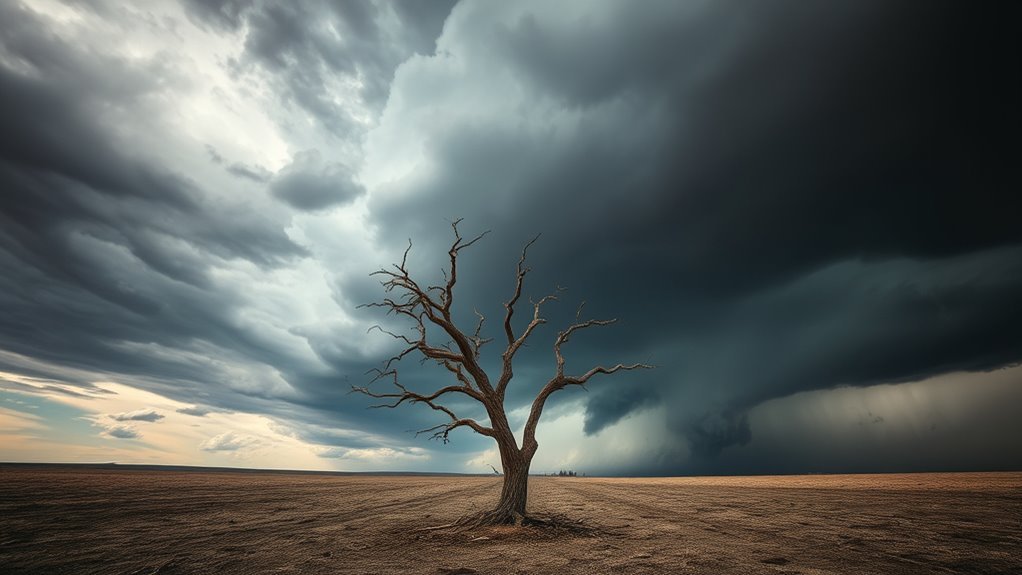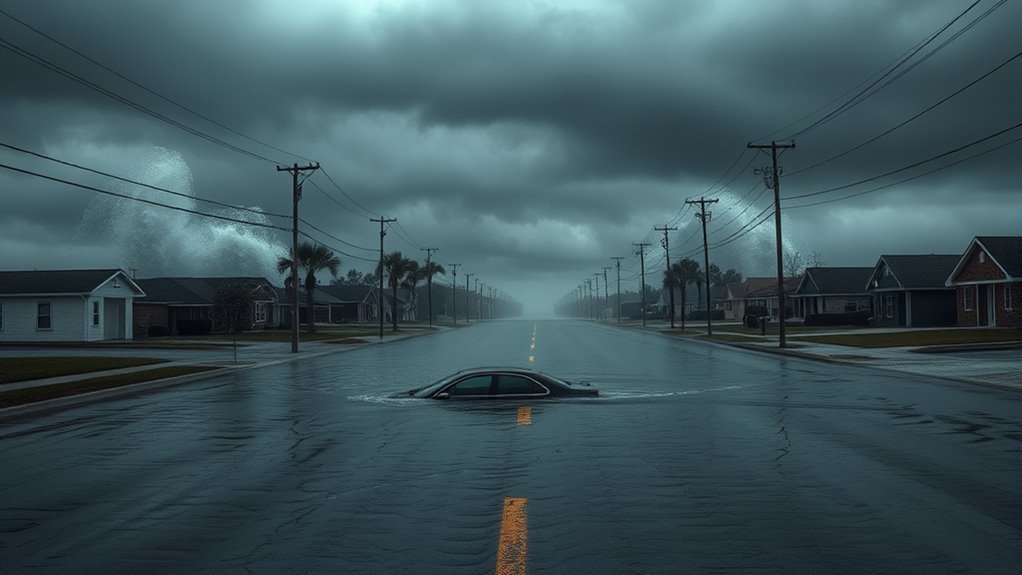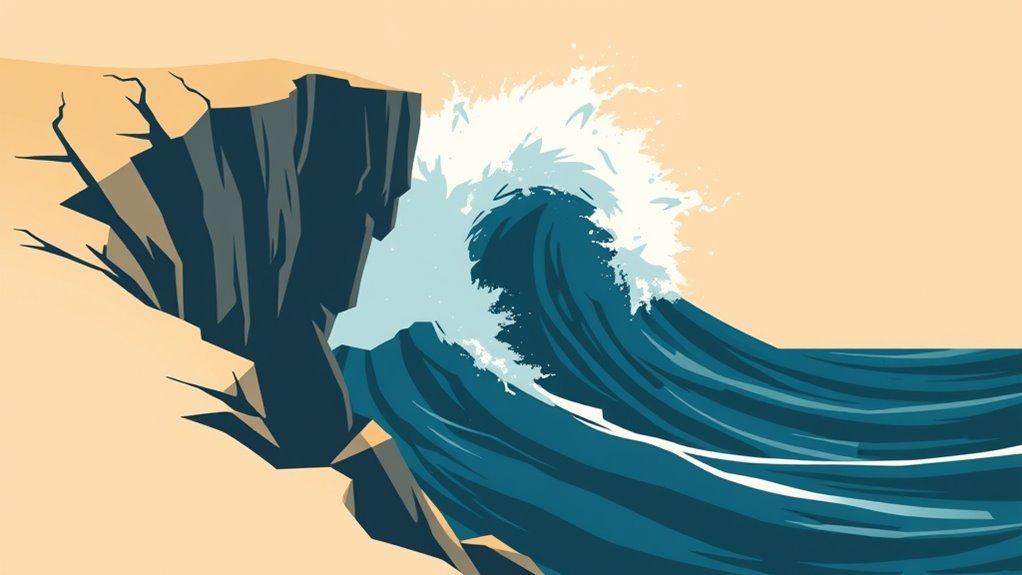Squall-induced disasters have greatly shaped modern weather history. Notable events include the Great Storm of 1987, which devastated southern England, and the 2011 Joplin Tornado, resulting in numerous fatalities and injuries. The 1991 Perfect Storm highlighted catastrophic potential, while Hurricane Harvey in 2017 caused unparalleled flooding in Texas. Recent occurrences, like the 2020 East Coast Derecho, demonstrate nature's unpredictability. These incidents illustrate the urgent need for improved preparedness and resilience in the face of extreme weather events. More perspectives await.
Main Points
- The Great Storm of 1987 in southern England caused extensive damage with winds up to 115 mph, leading to advancements in meteorological forecasting.
- The 1979 Fastnet Race Disaster resulted in the tragic loss of 15 sailors due to unexpected severe winds, prompting enhanced safety protocols in sailing.
- The 1991 Perfect Storm combined a nor'easter and remnants of Hurricane Grace, causing significant economic losses, particularly in the fishing industry.
- Hurricane Harvey in 2017 caused catastrophic flooding in Texas, displacing over 30,000 people and resulting in damages estimated at $125 billion.
- The 2020 East Coast Derecho produced wind gusts over 100 mph, leading to widespread destruction and highlighting the unique nature of such storms.
The Great Storm of 1987: A Wake-Up Call for Meteorology
Though often underestimated, the Great Storm of 1987 served as a critical moment in meteorology, dramatically illustrating the limitations of weather forecasting at the time.
On the night of October 15, a powerful extratropical cyclone unexpectedly swept across southern England, resulting in widespread destruction. Forecasters had predicted a mere autumnal gale, failing to anticipate the storm's intensity and rapid development. Winds reached up to 115 mph, leading to the uprooting of thousands of trees, structural damage, and tragic loss of life.
This event highlighted the inadequacies in meteorological models and communication strategies, prompting major changes in forecasting practices. The lack of accurate predictions raised public awareness of the importance of timely weather information.
As a result, meteorologists began investing in advanced technology and improved modeling techniques. The Great Storm not only reshaped public perception of weather forecasting but also served as a crucial lesson in the need for greater preparedness against severe weather events.
The Fastnet Race Disaster: A Tragic Lesson in Sailing Safety

The Great Storm of 1987 not only reshaped viewpoints on meteorological forecasting but also set the stage for future maritime disasters, most importantly the Fastnet Race disaster of 1979.
During this prestigious sailing event, competitors faced an unexpected and brutal storm that transformed the race into a nightmare. As winds reached over 50 knots, many boats capsized or were severely damaged, leading to chaos on the water.
In total, 15 sailors lost their lives, making it one of the most tragic incidents in sailing history. The disaster prompted a reevaluation of safety protocols and weather preparedness within the sailing community.
Navigators and crews were reminded of the unpredictable nature of maritime weather and the importance of accurate forecasting. This event eventually shaped new regulations aimed at ensuring better safety measures, emphasizing that even experienced sailors must respect the potential dangers posed by sudden squalls at sea.
The 1991 Perfect Storm: A Combination of Forces
The 1991 Perfect Storm emerged from a unique convergence of meteorological conditions, including a tropical storm, a cold front, and high-pressure systems.
This unusual combination created extraordinary wave heights and wind speeds, leading to catastrophic consequences for the fishing industry.
Fishermen faced considerable losses as their vessels were battered by the tumultuous seas, highlighting the storm's far-reaching impact.
Meteorological Conditions Overview
As a rare convergence of meteorological factors unfolded in late October 1991, the North Atlantic experienced one of the most severe storms in recorded history, known as the Perfect Storm.
This extraordinary event was defined by the interplay of a powerful nor'easter and the remnants of Hurricane Grace. The nor'easter intensified as it drew moisture from warm ocean waters, while Grace's remnants contributed to its development.
Additionally, the storm's formation was influenced by low-pressure systems and a high-pressure ridge that established a unique atmospheric environment. The collision of these forces created a volatile scenario, resulting in towering waves and ferocious winds.
This complex blend of conditions was essential in producing the catastrophic impacts associated with the Perfect Storm.
Impact on Fishing Industry
Severe storms like the Perfect Storm of 1991 can have devastating effects on local economies, particularly in the fishing industry.
The storm, defined by its unique combination of meteorological forces, wreaked havoc on fishing fleets and coastal communities. Fishermen faced considerable losses as boats were damaged or destroyed, and fishing operations halted during the storm's peak.
The aftermath saw reduced fish populations and disrupted supply chains, further impacting the industry.
- Damage to fishing vessels and equipment
- Disruption of fishing schedules and operations
- Economic losses for local fishermen and businesses
- Decline in fish stocks due to storm conditions
- Increased insurance costs and recovery expenses
The 2011 Joplin Tornado: When Squalls Turn Deadly

The 2011 Joplin Tornado serves as a stark reminder of how squall conditions can lead to devastating tornado formation.
Various atmospheric factors contributed to the storm's intensity, resulting in catastrophic effects on the Joplin community.
The aftermath highlighted both the immediate destruction and the long-term challenges faced by residents in recovery.
Tornado Formation Factors
Tornadoes often emerge from a complex interplay of atmospheric conditions, and the 2011 Joplin Tornado exemplifies how squall lines can escalate into deadly storms. Several factors contribute to the formation of tornadoes, particularly in the context of squall lines.
- Warm, moist air: This rising air fuels storm development.
- Cold, dry air aloft: It creates instability, enhancing vertical wind shear.
- Wind shear: The change in wind speed and direction with altitude is essential for rotation.
- Lift mechanisms: Cold fronts or outflow boundaries trigger upward motion in the atmosphere.
- Supercell thunderstorms: These rotating storms are often the precursors to tornado formation.
Understanding these factors aids in predicting the potential for tornadoes within squall line events like the one that struck Joplin.
Impact on Joplin Community
Although the Joplin community had long been aware of the threat posed by severe weather, the devastating tornado that struck on May 22, 2011, shattered their sense of security. This catastrophic event claimed 158 lives, injured over 1,000 residents, and destroyed approximately 7,500 homes.
The aftermath left a significant psychological impact, as survivors grappled with loss and trauma. Local infrastructure was severely damaged, complicating recovery efforts and displacing thousands.
Community organizations quickly mobilized to provide aid, showcasing resilience amid devastation. Schools, businesses, and hospitals faced extensive rebuilding challenges, yet the spirit of Joplin remained unbroken.
This disaster not only altered the physical terrain but also forged a stronger community bond, compelling residents to support each other in their shared journey of recovery.
The 2017 Hurricane Harvey: Flooding and Squalls Unite

As Hurricane Harvey released its fury in August 2017, the combination of unyielding flooding and squalls wreaked havoc across Texas. This catastrophic event became one of the most devastating natural disasters in U.S. history, as tireless rainfall inundated cities and towns, leading to extraordinary damage and loss of life.
The squalls associated with Harvey unleashed powerful winds and tornadoes, compounding the destruction. Emergency services struggled to respond amid rising waters, and many residents were trapped in their homes.
Key impacts of Hurricane Harvey included:
- Over 60 fatalities attributed to flooding and debris
- More than 30,000 people displaced from their homes
- An estimated $125 billion in damages
- Thousands of rescues conducted by local and federal agencies
- Long-term economic repercussions for the affected regions
The catastrophic interplay of flooding and squalls during Hurricane Harvey serves as a somber reminder of nature's potential for destruction.
The 2020 East Coast Derecho: A Sudden and Furious Onslaught
In August 2020, a powerful derecho swept across the East Coast, delivering a sudden and furious onslaught of severe weather. This intense windstorm originated in the Midwest, gathering momentum as it advanced, eventually affecting millions from Ohio to New Jersey.
With wind gusts exceeding 100 mph, the derecho uprooted trees, damaged homes, and disrupted power to over a million residents. The storm's rapid development and destruction led to widespread chaos and emergency responses.
Meteorologists highlighted the derecho's unique characteristics, noting its capacity to produce straight-line winds over extensive distances, unlike typical thunderstorms.
The aftermath left communities grappling with fallen debris and prolonged power outages, as emergency crews worked tirelessly to restore services.
The 2020 East Coast derecho stands as a stark reminder of nature's unpredictability, illustrating the potential for severe squall-induced disasters to emerge swiftly and with devastating effects.
The 2021 Pacific Northwest Windstorm: Nature's Unpredictable Fury
When the 2021 Pacific Northwest windstorm struck, it released a ferocity that caught many residents off guard. This unexpected event brought powerful gusts, causing widespread damage across the region.
Trees were uprooted, power lines were downed, and homes faced severe structural impacts. Emergency services struggled to respond as roads became impassable, and thousands lost electricity for days. The storm served as a grim reminder of nature's unpredictability.
- Wind gusts reached up to 100 mph
- Over 200,000 residents experienced power outages
- Notable damage reported in Seattle and surrounding areas
- Emergency declarations issued by local governments
- Recovery efforts took weeks to complete
The aftermath of the windstorm highlighted the importance of preparedness and resilience in the face of extreme weather, leaving a lasting impact on the community and its infrastructure.
Common Questions
What Is a Squall and How Does It Form?
A squall is a sudden, sharp increase in wind speed, often accompanied by precipitation. It typically forms when cold air pushes under warm air, creating instability and leading to rapid weather changes over a localized area.
How Can I Prepare for a Squall?
To prepare for a squall, individuals should stay informed about weather alerts, secure loose outdoor items, seek shelter indoors, and have emergency supplies ready, ensuring safety during sudden and severe weather changes.
Are Squalls More Common in Certain Regions?
Squalls tend to be more common in specific regions, particularly coastal areas and places with notable temperature contrasts. Meteorological conditions, such as warm air meeting cooler air, often create the ideal environment for squall development.
What Safety Measures Should Be Taken During a Squall?
During a squall, individuals should seek shelter indoors, avoid windows, secure outdoor objects, and stay informed through reliable weather updates. Additionally, having an emergency kit and a communication plan improves preparedness for sudden weather changes.
How Do Squalls Differ From Hurricanes and Tornadoes?
Squalls are brief, intense storms defined by sudden wind shifts and heavy precipitation, differing from hurricanes, which are large, organized systems with sustained winds, and tornadoes, which are violent, rotating columns of air.

